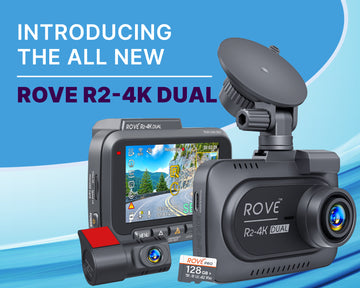DISTORTION CORRECTION FEATURE
The ROVE R2-4K’s distortion corrected lenses ensure accurate and proportional images capture. The Distortion Correction feature in our R2-4K dashcam enables it to rectify any images' distortions automatically, converting the footage into its exact shape for you. This feature employed in your dashcam eliminates the worry about deformed images due to dashcam lenses' rounded and wide-angle design.

WHAT IS THE DISTORTION CORRECTION
What is the "Distortion Correction" feature in ROVE R2-4K DASH CAM?
Rove R2-4K dashcam offers an incredibly helpful feature, which is known as Proprietary Distortion Correction Algorithm. This feature is positioned under the video setting domain in the dash cam, where you can switch this distortion correction characteristic ON or OFF according to your desire.
The distortion correction element in the Rove R2-4K dash cams allows the camera to digitally rectify any optical distortion in the images by employing the distortion correction algorithm – this algorithm automatically converts the visually deformed image\video into its accurate shape for you, when it is turned ON to operate.
To get a deep clarification of the distortion feature in the dashcam, you will require a clear awareness of the below fundamentals.

What is Image Distortion and why does it occur?
In digital photography, the term 'Distortion' is specifically used for a certain optical aberration in a camera that deforms and twists physically upright lines in the produced images and makes the image appear curvy.
While capturing an image or video in a camera through lenses, you may have discovered that the captured image turned out to be different in shape form the real object – the image may appear hemispherical at its edges, warped, or crooked. This effect is known as the Optical Distortion or the Fisheye effect.
Optical distortion or the deformation in the captured image occurs as a result of the rounded and wide-angle design of the lens, used in the dash camera – hence the optical distortion is counted under the lens distortion category.
Sometimes even optical distortion occurs due to the certain lens components that are employed to diminish other visual deformations like spherical aberrations. In short, optical distortion is a default error caused by camera lenses.

Classifications of Optical Distortion
There are primarily two known categories of optical distortion, Barrel, and Pincushion distortion. Let's go through each in detail — but before we commit that, let’s take a glance at a picture with no lens distortion to obtain a deep understanding:

This is a picture of the image lines that suffered no lens distortions. 'No lens distortion' is a rare occurrence because maximum lenses undergo at least one kind of distortion defined below.
1.Barrel Distortion
When the straight lines of the image are concave inwards which can be compared to the structure of a barrel, this category of aberration is called “barrel distortion”. This type of distortion in images is typically found on wide-angle camera lenses. The barrel distortion arises due to the field of view of the lens that is extensively vaster than the size of the image sensor and therefore it imposes to be “squeezed” to work out. As a result, flat lines are visibly cupped inwards, particularly towards the extreme borders of the frame.
Observe that the lines seem straight at the ultimate core of the frame and only initiate tilting, out from the center, because the image is indistinguishable in the optical axis (i.e. the middle of the lens), but its elaboration reduces towards the corners.

2.Pincushion Distortion
The following category of optical distortion is Pincushion distortion which is exactly the opposite of barrel distortion – flat lines tend to concave outwards from the midst.
This kind of distortion is generally detected on telephoto lenses, and it happens because of image magnification that increases towards the ends of the frame from the optic axis (i.e. the middle of the lens). In this situation, the FOV (field of view) is smaller than the scope of the image sensor and therefore it requires to be “stretched” to fit. As an outcome, upright lines appear to be dragged upwards in the corners, as shown in the image.

How does the Distortion Correction feature assist you?
Presently, as you are familiar with what optical distortion is and how it occurs, you can now relate to the distortion correction algorithm feature in the Rove R2-4K dash cam. As it is mentioned in the name of the feature itself 'Distortion Correction', accordingly this feature allows the camera to digitally convert and correct the captured visually deformed image, into its original and accurate shape, automatically without any of your efforts when the feature is turned ON to operate.
Having control on distortion as a feature in your dash camera, you do not need to bother about any type of visual distortions that occurs while capturing an image or video through wide-angle lenses – no matter your captured image suffers Barrel distortion or Pincushion distortion, the distortion correction algorithm in your Rove R2-4K dash cam will remove all the misshaping from the image and make it a no optical distortion image.






